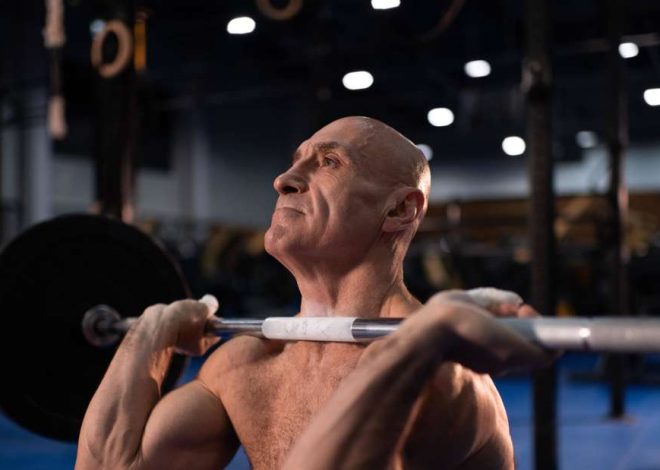
Can I build muscle while jogging?
Cardio and strength training sessions are typically considered useful for different purposes: running is designed to move your body, burn calories, and train your cardiovascular system, while a dumbbell workout is designed to build strength and muscle. This is the supposed order of things. But maybe you see a muscular guy on your run and wonder what his workout routine is. Can you build muscle just by running?
The short answer: no – at least not in the same way as with strength training. You shouldn’t expect to experience the same level of muscle growth from running as you can from weight lifting. However, there are some circumstances in which you may be able to accelerate muscle growth through running.
“If you’re untrained and do some running, you’ll see extra lean muscle mass,” says US fitness expert and nutrition coach Mike Nelson of the Carrick Institute in Florida. “But if you’re more trained, running is probably not a sufficient stimulus to directly increase lean muscle mass.”
But even if you’re already trained, certain forms of running can help enlarge your thigh muscles and replace some fitness equipment. And jogging could also improve the results of your efforts in the gym. Nelson and Percell Dugger, running trainers and founders of the fitness platform “Fit for Us,” explain how.

- Endurance for strength athletes
- Targeted mix of endurance runs and HIIT units
- only 2 running sessions per week necessary
- available on every device
Log in here one.
After successful payment you will receive an email with a download link. If you have any questions, send a message to [email protected].
How running builds muscle
There aren’t many studies on running and muscular hypertrophy, but the few that exist support Nelson: In a small 2017 study of untrained 19- and 20-year-olds who ran high-intensity intervals three times a week for 10 weeks the size of the subjects’ thigh muscles increased by 10 percent. A much older study that tested older, untrained men found that men in their 60s and 70s increased their thigh size by nine percent after six months of steady running.
The reason these muscle gains don’t continue has to do with the amount of time the muscles are under tension, says Nelson. When you do strength training, the trained muscles are challenged for an entire repetition. “Running creates more of an impulse load or shock load that is really, really short,” says Nelson. Although the load can be huge—four to six times your body weight—the muscles aren’t under tension for as long as they are during a few sets of resistance training, he says.
Just because the short bursts of running don’t build significant muscle in other parts of the body doesn’t mean they don’t make the legs stronger, says expert Dugger.
The belief that running makes you weaker stops many from doing cardio, even though their health and well-being – and strength training – could benefit from it.
How running can improve muscle building
While running alone doesn’t build a lot of muscle mass, it can help build muscle in the long term, says Nelson—as long as you combine it with strength training.
There are two reasons for this: First, running increases your aerobic threshold, or your ability to recover quickly from a workload. Someone who has a low VO2 max, or aerobic threshold, is also likely to be less able to achieve and train in the gym because they can’t recover as quickly, the expert said. Running regularly ensures that you can complete more sets, more repetitions and more workouts when strength training. And all of this leads to more muscle.
The second reason: When you do endurance training, your body creates more capillaries in your muscles. This increase in small blood vessels increases blood flow to your muscles.
Why it’s important: “Let’s say you’re doing a set of leg extensions. At some point you’re not getting enough blood flow in the muscle, not enough oxygen is being delivered to the muscle. So it becomes painful and you have to stop,” he says. “If you can get more blood flow to that muscle, you can theoretically do more work and build more muscle.”
Don’t worry that adding running to your strength training will limit your muscle gains, as is often thought. A 2021 systematic review of 43 studies published in the journal Sports Medicine concluded that “simultaneous aerobic and resistance training does not impair the development of maximal strength and muscle hypertrophy compared to resistance training alone.”
Basically, this means you can continue to build strength and muscle while also training for endurance. Just remember that your runs are not the direct cause of muscle growth.
How to use climbs to build muscle
Running can not only improve your muscle growth, but it can also support parts of your strength training routine, says Dugger. For this you need a hill. “For example, when training with a weight sled, find a steep hill and run up it as fast as you can,” he says. “I promise you: your heart and head will feel like you’re pulling a 500-pound sled or wearing a 50-pound vest.”
For those who don’t have access to equipment or like to train outside, hill sprints like these get the same high-intensity, muscle-building finish as expensive weight sleds.
Compared to regular sprints, which can lead to injury if you’re not used to such speeds, uphill sprints are similarly intense while slowing you down.
Important: Running downhill is a completely different challenge. And it puts strain on different muscles than when climbing. On the way up, your thighs work, while on the way down, your lower legs (calves and shin muscles) are challenged more. So if you want to do hill sprints, choose a steep hill that you run up a few times a week. But: “walk” down the hill before sprinting again.

- Endurance for strength athletes
- Targeted mix of endurance runs and HIIT units
- only 2 running sessions per week necessary
- available on every device
Log in here one.
After successful payment you will receive an email with a download link. If you have any questions, send a message to [email protected].
Sources used:
Estes RR, Malinowski A, Piacentini M, Thrush D, Salley E, Losey C, Hayes E. The Effect of High Intensity Interval Run Training on Cross-sectional Area of the Vastus Lateralis in Untrained College Students. Int J Exerc Sci. 2017 Jan 1;10(1):137-145. PMID: 28479954; PMCID: PMC5214170.
Schumann, M., Feuerbacher, JF, Sünkeler, M. et al. Compatibility of concurrent aerobic and strength training for skeletal muscle size and function: an updated systematic review and meta-analysis. Sports Med 52, 601–612 (2022). https://doi.org/10.1007/s40279-021-01587-7

Ethel Purdy – Medical Blogger & Pharmacist
Bridging the world of wellness and science, Ethel Purdy is a professional voice in healthcare with a passion for sharing knowledge. At 36, she stands at the confluence of medical expertise and the written word, holding a pharmacy degree acquired under the rigorous education systems of Germany and Estonia.
Her pursuit of medicine was fueled by a desire to understand the intricacies of human health and to contribute to the community’s understanding of it. Transitioning seamlessly into the realm of blogging, Ethel has found a platform to demystify complex medical concepts for the everyday reader.
Ethel’s commitment to the world of medicine extends beyond her professional life into a personal commitment to health and wellness. Her hobbies reflect this dedication, often involving research on the latest medical advances, participating in wellness communities, and exploring the vast and varied dimensions of health.
Join Ethel as she distills her pharmaceutical knowledge into accessible wisdom, fostering an environment where science meets lifestyle and everyone is invited to learn. Whether you’re looking for insights into the latest health trends or trustworthy medical advice, Ethel’s blog is your gateway to the nexus of healthcare and daily living.



